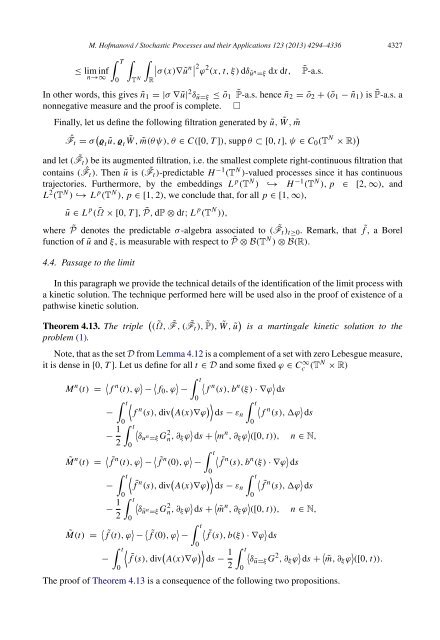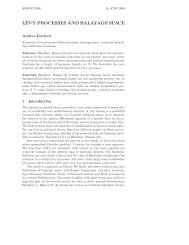Degenerate parabolic stochastic partial differential equations
Degenerate parabolic stochastic partial differential equations
Degenerate parabolic stochastic partial differential equations
You also want an ePaper? Increase the reach of your titles
YUMPU automatically turns print PDFs into web optimized ePapers that Google loves.
M. Hofmanová / Stochastic Processes and their Applications 123 (2013) 4294–4336 4327<br />
T <br />
<br />
≤ lim inf σ (x)∇ũ<br />
n→∞ 0<br />
T n 2 ϕ 2 (x, t, ξ) dδũn =ξ dx dt,<br />
N R<br />
˜P-a.s.<br />
In other words, this gives ñ 1 = |σ ∇ũ| 2 δũ=ξ ≤ õ 1 ˜P-a.s. hence ñ 2 = õ 2 + (õ 1 − ñ 1 ) is ˜P-a.s. a<br />
nonnegative measure and the proof is complete. □<br />
Finally, let us define the following filtration generated by ũ, ˜W , ˜m<br />
Fˆ<br />
t = σ ϱ t ũ, ϱ t<br />
˜W , ˜m(θψ), θ ∈ C([0, T ]), supp θ ⊂ [0, t], ψ ∈ C 0 (T N × R) <br />
and let ( F˜<br />
t ) be its augmented filtration, i.e. the smallest complete right-continuous filtration that<br />
contains ( Fˆ<br />
t ). Then ũ is ( F˜<br />
t )-predictable H −1 (T N )-valued processes since it has continuous<br />
trajectories. Furthermore, by the embeddings L p (T N ) ↩→ H −1 (T N ), p ∈ [2, ∞), and<br />
L 2 (T N ) ↩→ L p (T N ), p ∈ [1, 2), we conclude that, for all p ∈ [1, ∞),<br />
ũ ∈ L p ( ˜Ω × [0, T ], ˜P, dP ⊗ dt; L p (T N )),<br />
where ˜P denotes the predictable σ -algebra associated to ( F˜<br />
t ) t≥0 . Remark, that<br />
function of ũ and ξ, is measurable with respect to ˜P ⊗ B(T N ) ⊗ B(R).<br />
4.4. Passage to the limit<br />
˜ f , a Borel<br />
In this paragraph we provide the technical details of the identification of the limit process with<br />
a kinetic solution. The technique performed here will be used also in the proof of existence of a<br />
pathwise kinetic solution.<br />
Theorem 4.13. The triple ( ˜Ω, F ˜ , ( F˜<br />
t ), ˜P), ˜W , ũ is a martingale kinetic solution to the<br />
problem (1).<br />
Note, that as the set D from Lemma 4.12 is a complement of a set with zero Lebesgue measure,<br />
it is dense in [0, T ]. Let us define for all t ∈ D and some fixed ϕ ∈ Cc ∞(TN × R)<br />
M n (t) = f n (t), ϕ − f 0 , ϕ <br />
− f n (s), b n (ξ) · ∇ϕ ds<br />
0<br />
t <br />
− f n (s), div A(x)∇ϕ t <br />
ds − ε n f n (s), ϕ ds<br />
− 1 2<br />
0 t<br />
0<br />
t<br />
<br />
δu n =ξ G 2 n , ∂ ξ ϕ ds + m n , ∂ ξ ϕ ([0, t)), n ∈ N,<br />
t<br />
˜M n (t) = f˜<br />
n (t), ϕ − f˜<br />
n (0), ϕ −<br />
0<br />
t <br />
− f ˜ n (s), div A(x)∇ϕ t<br />
ds − ε n<br />
0 t<br />
0<br />
˜ f n (s), b n (ξ) · ∇ϕ ds<br />
0<br />
˜ f n (s), ϕ ds<br />
− 1 <br />
2<br />
δũn =ξ G 2 n , ∂ ξ ϕ ds + ˜m n , ∂ ξ ϕ ([0, t)), n ∈ N,<br />
0<br />
˜M(t) = f ˜(t), ϕ − f ˜(0), ϕ t <br />
− f ˜ (s), b(ξ) · ∇ϕ ds<br />
0<br />
t <br />
− f ˜ (s), div A(x)∇ϕ ds − 1 t <br />
δũ=ξ G 2 , ∂ ξ ϕ ds + ˜m, ∂ ξ ϕ ([0, t)).<br />
2<br />
0<br />
The proof of Theorem 4.13 is a consequence of the following two propositions.<br />
0



